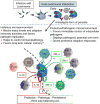Immunoregulation in human American leishmaniasis: balancing pathology and protection
- PMID: 24471648
- PMCID: PMC4113557
- DOI: 10.1111/pim.12100
Immunoregulation in human American leishmaniasis: balancing pathology and protection
Abstract
Leishmaniasis covers a broad spectrum of diseases with distinct, and sometimes overlapping, characteristics. The common thread in all forms of leishmaniasis is the infection by the parasite Leishmania belonging to the genus Leishmania. Upon infection of humans, there can be at least three outcomes, (i) control of Leishmania by the host immune response resulting in asymptomatic disease, (ii) patent infection and development of a relatively mild form of leishmaniasis and (iii) patent infection and development of severe clinical forms. The factors that determine the outcome of an initial inoculation with Leishmania are many, with the species of Leishmania representing one of the strongest predictive factors for the development of a given clinical form of disease. This is seen with L. braziliensis and L. amazonensis, infection leading mostly to tegumentary forms of disease, and L. infantum with the potential to induce visceral disease. However, it is also clear that the host immune response is a key factor in disease progression, not only responsible for control of Leishmania, but also playing an important role in disease progression and pathology. This duality between protective and pathogenic immune responses in individuals infected with Leishmania in the Americas is the focus of this review.
Keywords: CD4 T lymphocytes; cytokine; human; immunopathology; immunoregulation; leishmaniasis.
© 2014 John Wiley & Sons Ltd.
Figures




Similar articles
-
Toll-like receptors 2, 4, and 9 expressions over the entire clinical and immunopathological spectrum of American cutaneous leishmaniasis due to Leishmania(V.) braziliensis and Leishmania (L.) amazonensis.PLoS One. 2018 Mar 15;13(3):e0194383. doi: 10.1371/journal.pone.0194383. eCollection 2018. PLoS One. 2018. PMID: 29543867 Free PMC article.
-
The Paradox of a Phagosomal Lifestyle: How Innate Host Cell-Leishmania amazonensis Interactions Lead to a Progressive Chronic Disease.Front Immunol. 2021 Sep 7;12:728848. doi: 10.3389/fimmu.2021.728848. eCollection 2021. Front Immunol. 2021. PMID: 34557194 Free PMC article. Review.
-
[Immunopathology of American tegumentary leishmaniasis].Acta Cient Venez. 1998;49(1):42-56. Acta Cient Venez. 1998. PMID: 10205916 Review. Spanish.
-
In Vivo Infection with Leishmania amazonensis to Evaluate Parasite Virulence in Mice.J Vis Exp. 2020 Feb 20;(156). doi: 10.3791/60617. J Vis Exp. 2020. PMID: 32150165
-
Does the Leishmania major paradigm of pathogenesis and protection hold for New World cutaneous leishmaniases or the visceral disease?Immunol Rev. 2004 Oct;201:206-24. doi: 10.1111/j.0105-2896.2004.00190.x. Immunol Rev. 2004. PMID: 15361243 Review.
Cited by
-
Association of the Endobiont Double-Stranded RNA Virus LRV1 With Treatment Failure for Human Leishmaniasis Caused by Leishmania braziliensis in Peru and Bolivia.J Infect Dis. 2016 Jan 1;213(1):112-21. doi: 10.1093/infdis/jiv354. Epub 2015 Jun 29. J Infect Dis. 2016. PMID: 26123565 Free PMC article.
-
Cutaneous Leishmaniasis Vaccination: A Matter of Quality.Front Immunol. 2016 Apr 21;7:151. doi: 10.3389/fimmu.2016.00151. eCollection 2016. Front Immunol. 2016. PMID: 27148270 Free PMC article. Review.
-
Analysis of the Antigenic and Prophylactic Properties of the Leishmania Translation Initiation Factors eIF2 and eIF2B in Natural and Experimental Leishmaniasis.Front Cell Infect Microbiol. 2018 Apr 5;8:112. doi: 10.3389/fcimb.2018.00112. eCollection 2018. Front Cell Infect Microbiol. 2018. PMID: 29675401 Free PMC article.
-
Tegumentary leishmaniasis mimicking visceralization in a cirrhotic patient: atypical cutaneous lesions and local immunological features.Rev Soc Bras Med Trop. 2020 Jan 27;53:e20190380. doi: 10.1590/0037-8682-0380-2019. eCollection 2020. Rev Soc Bras Med Trop. 2020. PMID: 31994668 Free PMC article.
-
Leishmania infection: painful or painless?Parasitol Res. 2017 Feb;116(2):465-475. doi: 10.1007/s00436-016-5340-7. Epub 2016 Dec 9. Parasitol Res. 2017. PMID: 27933392 Review.
References
-
- Murray HW, Berman JD, Davies CR, Saravia NG. Advances in leishmaniasis. Lancet. 2005;366(9496):1561–77. - PubMed
-
- Kaye P, Scott P. Leishmaniasis: complexity at the host-pathogen interface. Nat Rev Microbiol. 2011;9(8):604–15. - PubMed
-
- Afonso L, Borges VM, Cruz H, Ribeiro-Gomes FL, DosReis GA, Dutra AN, et al. Interactions with apoptotic but not with necrotic neutrophils increase parasite burden in human macrophages infected with Leishmania amazonensis. J Leukoc Biol. 2008;84(2):389–96. - PubMed
-
- Novais FO, Santiago RC, Bafica A, Khouri R, Afonso L, Borges VM, et al. Neutrophils and macrophages cooperate in host resistance against Leishmania braziliensis infection. J Immunol. 2009;183(12):8088–98. - PubMed
Publication types
MeSH terms
Grants and funding
LinkOut - more resources
Full Text Sources
Other Literature Sources
Research Materials

